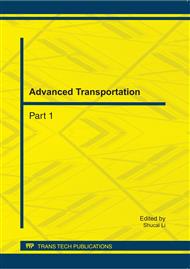p.208
p.214
p.220
p.226
p.230
p.235
p.241
p.247
p.251
Analysis of Temperature-Load Coupling Stress for Asphalt Overlay Using Three-Dimensional Finite Element Model
Abstract:
According to bond condition was simulated by contact unit and pavement parameters, such as temperature, load, and structural condition were given, a three-dimensional finite element model was established to analyze the temperature-load coupling stress for asphalt overlay. Effects of parameters for asphalt overlay, old cement concrete plate, joint and foundational response modulus on its temperature-load stress. Results show that the temperature-load stress of asphalt overlay is great influenced by asphalt overlay’s E1 and thickness h1, the thickness of the cement concrete slab h2, foundational response modulus k and the joint width δ. But the length L and width B of cement concrete slab, and the joint load transfer stiffness C has little effect on it. The temperature-load stress of overlay can be reduced by increasing the thickness of asphalt surface.
Info:
Periodical:
Pages:
230-234
Citation:
Online since:
September 2011
Authors:
Price:
Сopyright:
© 2011 Trans Tech Publications Ltd. All Rights Reserved
Share:
Citation:


